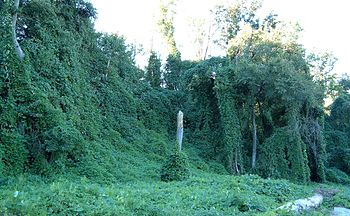 |
| Kudzu on trees in Atlanta, Georgia, USA (Wikipedia) |
Globally, biodiversity is in trouble, and new research shows that the situation is unlikely to improve over the next five years.
Researchers from around the world analysed global progress towards meeting the 20 international “Aichi Biodiversity Targets” by 2020 as set under the Convention on Biological Diversity in 2010. The results were published today in Science.
The mid-decade analysis found that while knowledge of the biodiversity crisis had greatly improved, more action is needed to reduce pressure on biodiversity and preserve ecosystems. 168 countries are party to the convention, including Australia.
Most of the Aichi targets lack quantitative measures, so the researchers had to find 55 other indicators that could show how the world is progressing.
One of the indicators used is the World Wildlife Fund Living Planet Index, which monitors more than 10,000 populations of mammals, birds, reptiles, amphibians and fish. The 2014 Living Planet Report, released this week, showed that these populations have declined by more than half since 1970.
To find out how biodiversity will be fairing in 2020, the researchers used projections. The findings suggest that while there will be continuing improvement in knowledge and funding, on current trends the state of biodiversity, threats and ecosystem services will all worsen by 2020.
Targets to combat pollution, invasive species, habitat loss and climate change will likely miss their mark, although a target to protect 17% of land area will likely be met.
Professor Melodie McGeoch, ecologist at Monash University, said that while the projections are grim, they don’t have to be. “Unlike climate change projections, we are not committed to these trajectory estimates. They can be turned around, or at least slowed down".
“One of the most important reasons for having these targets is to leverage action and investment to achieving them. There are some signs that this is happening, but clearly not enough and not enough fast enough.”
Biodiversity measures ‘far from adequate’
Professor McGeoch also said the indicators used for biodiversity are “far from adequate” in, for example, invasive species. “There is no doubt that the invasive species problem continues to worsen (more species are becoming invasive and more places are being invaded). What we can’t say with much confidence is the rate at which this is happening.”
But progress is being made to address data deficiencies, such as the Global Invasive Species Information Partnership.
Dr Emily Nicholson, conservation researcher at University of Melbourne, said few measurements of biodiversity have been tested. In related research, also published today in Science, Nicholson found that indicators such as the Living Planet Index are “robust”, but depend on the quality of data.
For example, Nicholson highlighted that birds - favoured by amateur and professional naturalists alike - often make up a large part of ecological data.
“There is a lot of data on bird populations. This is especially pronounced within marine ecosystems where bird data can make up more than half of the data … this means that the trends shown in the index in those systems will be heavily influenced by what is happening to seabirds.”
She said modelling was one way to improve biodiversity measurements, which had been used successfully in fisheries.
This article was originally published on The Conversation. Read the original article.
No comments:
Post a Comment